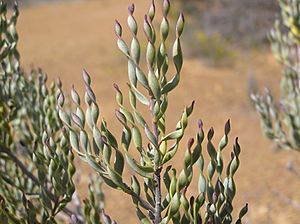Persoonia helix facts for kids
Quick facts for kids Persoonia helix |
|
|---|---|
 |
|
| Scientific classification | |
| Genus: |
Persoonia
|
| Species: |
helix
|
 |
|
| Occurrence data from Australasian Virtual Herbarium | |
Persoonia helix is a type of flowering plant. It belongs to the Proteaceae family. This plant grows only in the southwest part of Western Australia. It is a shrub that can stand tall or spread out. Its young branches are a bit hairy. The leaves are twisted, and its flowers are bright yellow. These flowers can grow alone or in small groups of up to five. They appear on a stem called a rachis, which can be up to 25 millimeters long.
Contents
What Persoonia helix Looks Like
Persoonia helix is a shrub that can grow tall or spread out. It usually reaches a height of 0.4 to 2.8 meters. The plant has smooth bark. Its young branches are covered in hair for the first few years.
The leaves grow one after another along the stem. They are mostly long and narrow, about 20 to 60 millimeters long. They are also 1.5 to 4 millimeters wide. A cool thing about these leaves is that they can twist up to six full turns!
Flowers and Fruit
The bright yellow flowers grow alone or in groups of up to five. They are found along a stem called a rachis, which can be up to 25 millimeters long. After the plant flowers, this rachis often grows into a leafy shoot. Each flower sits on a small stalk called a pedicel, which is 3 to 6 millimeters long.
The flower parts, called tepals, are bright yellow and 8 to 11 millimeters long. Inside, the bright yellow anthers curve outwards at their tips. Persoonia helix flowers from November to December or from January to February. After flowering, it produces a smooth, oval fruit. This fruit is a type of drupe, about 7 to 9.5 millimeters long and 4.5 to 7 millimeters wide.
How Persoonia helix Got Its Name
The plant Persoonia helix was officially described in 1994. This description was made by a scientist named Peter Henry Weston. He wrote about it in a science journal called Telopea. The plants he studied were collected by Fred Lullfitz in 1964. They were found near a place called Forrestania.
Where Persoonia helix Grows
This type of geebung plant lives in certain areas of Western Australia. It grows in open areas with low shrubs, called heathland. It also grows in areas with many trees, known as woodland. You can find it in the region between Kalgoorlie, Hyden, Ravensthorpe, and Salmon Gums. These areas are part of the Coolgardie, Esperance Plains, and Mallee biogeographic regions. These regions are natural areas with similar plants and animals.
Is Persoonia helix Protected?
The government of Western Australia keeps track of plants and animals. The Western Australian Government Department of Parks and Wildlife has classified Persoonia helix as "not threatened." This means it is not currently at risk of disappearing.

